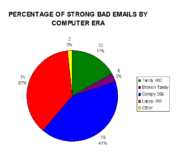Strong Bad Email Statistics
From Homestar Runner Wiki
(Difference between revisions)
(Added Thumbnail Pic) |
(+2 images with captions. For now, the descriptions for the bar/pie graphs are left "open for interpretation" (as Homsar would say)) |
||
| Line 24: | Line 24: | ||
**The equation for the LSRL is y = 1.3848x + 44.831. y = Time (seconds); x = Email number | **The equation for the LSRL is y = 1.3848x + 44.831. y = Time (seconds); x = Email number | ||
*This method of guessing is not 100% accurate, since it is unlikely the e-mails will ever be, say, 20 minutes long. This equation should not be considered a foolproof method for guessing the length of an e-mail. | *This method of guessing is not 100% accurate, since it is unlikely the e-mails will ever be, say, 20 minutes long. This equation should not be considered a foolproof method for guessing the length of an e-mail. | ||
| + | |||
| + | [[Image:bar_graph_by_length.PNG|thumb|left|"The newer, the longer"]] | ||
| + | |||
| + | [[Image:pie_graph_by_era.PNG|thumb|right|[[Compy 386]] wins here]] | ||
Revision as of 10:47, 27 March 2005
Various statistics of interest involving Strong Bad Email data.
Strong Bad Email By Length
This section involves data taken from the list Strong Bad Email By Length.
- The scatter plot shows a fairly strong positive correlation between Email Number and Email Length. The r value between these two variables without deleting outliers is .844.
- A r value of 1 would indicate a perfect, positive correlation. A value of -1 indicates a perfect, negative correlation. Therefore, .844 indicates a fairly strong, positive correlation.
- This plot shows there are a handful of clear outliers which are likely effecting the correlation. In the plot below, the outliers have been removed. A Least Squares Regression Line (LSRL) has also been added.
- The outliers were defined as those emails with a residual value of 40 or greater, or -40 or less.
- The LSRL can be used to extrapolate, or guess the length of future emails. The r value of this line is .946.
- The equation for the LSRL is y = 1.3848x + 44.831. y = Time (seconds); x = Email number
- This method of guessing is not 100% accurate, since it is unlikely the e-mails will ever be, say, 20 minutes long. This equation should not be considered a foolproof method for guessing the length of an e-mail.

Compy 386 wins here




